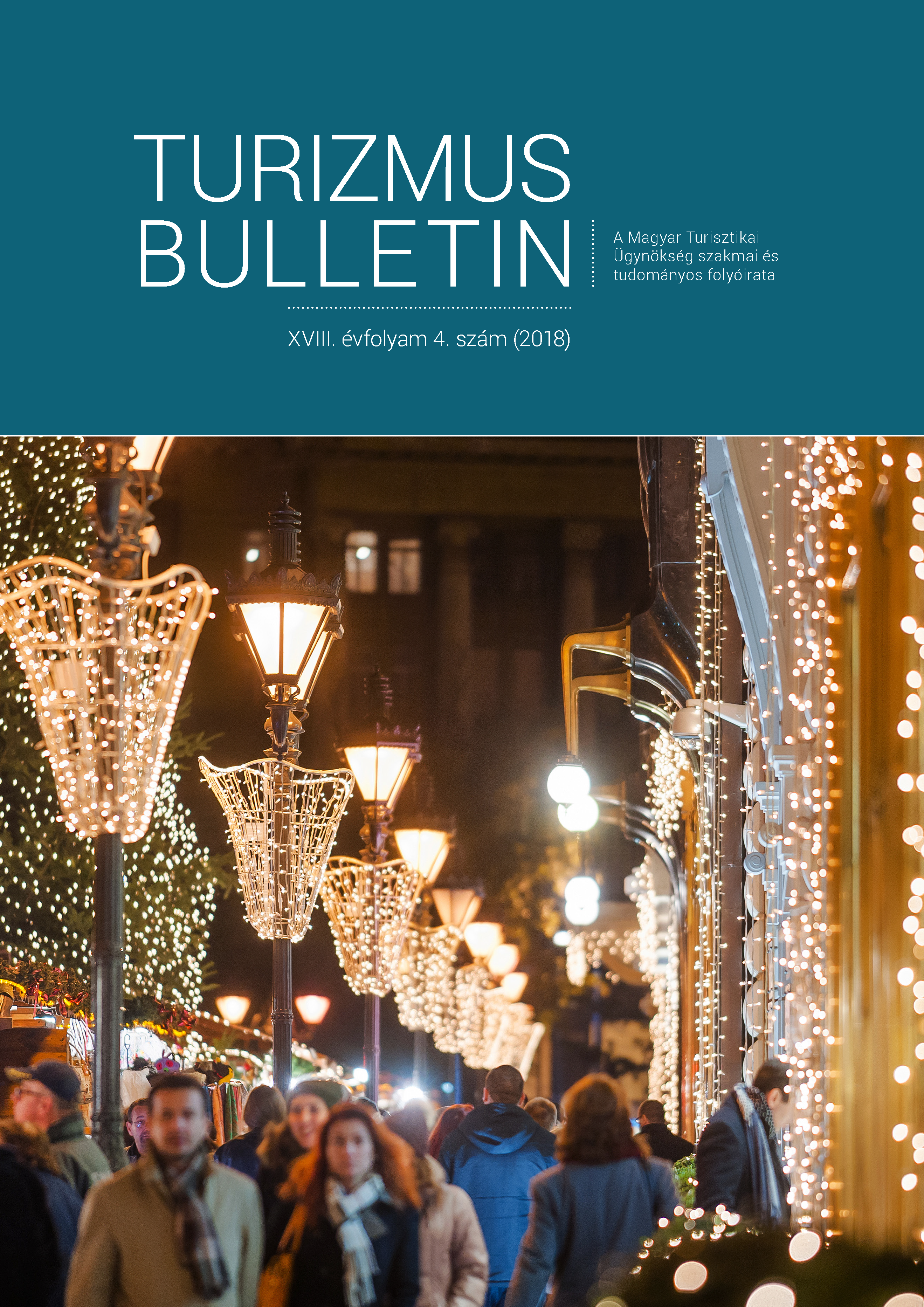Kreatív turizmus Budapesten – Szabadulószobák az innovatív turisztikai piacon
DOI:
https://doi.org/10.14267/TURBULL.2018v18n4.4Kulcsszavak:
kreatív turizmus, gamifikáció, szabadulószobák, BudapestAbsztrakt
Az elmúlt évtizedben a városi turizmus kínálatában a hagyományos elemek mellett új, innovatív termékek jelentek meg. A kreatív turizmus különösen olyan desztinációk esetében fejlődik gyorsan, amelyek az élményszerzés és aktivitás új, alternatív formáit keresik és alkalmazzák. A kreatív turizmus egyik új fejlődési iránya a gamifikáció, amikor egy játék áll a turisztikai aktivitás középpontjában, és új vonzerőként ez szolgáltat emlékezetes élményeket a turisták számára. Napjainkban a kreatív turizmus és gamifikáció egyik nemzetközi szinten is legnépszerűbb szolgáltatása a szabadulószoba, amelynek európai meghonosításában a magyar szolgáltatók úttörő szerepet játszottak. Tanulmányunkban longitudinális internetes weboldalelemzés, tartalomelemzés, terepbejárás és empirikus megfigyelések eredményein keresztül először rendszerezzük és kategorizáljuk Budapest kreatív turisztikai kínálatát, majd részletesen bemutatjuk a szabadulószoba szolgáltatások kínálati piacát és a szabadulójátékok legfontosabb jellemzőit. A nemzetközi összehasonlítás és konkurenciaelemzés segítségével a budapesti szabadulószoba-piac nemzetközi versenyképességét és pozícióját elemezzük.
Hivatkozások
BOES, K. – BUHALIS, D. – INVERSINI, A. (2015): Conceptualising smart tourism destination dimensions. In: Tussyadiah, L. – Inversini, A. (eds): Information and communication technologies in tourism. Springer, Wien. pp. 391-403.
BULENCER, P. – EGGER, R. (2015): Gamification in Tourism, designing memorable experiences. Books on Demand, Norderstedt.
CORREA, C. – KITANO, C. (2015): Gamification in Tourism: Analysis of Brazil Quest Game. e-Review of Tourism Research. 6. pp. 1-5.
DETERDING, S. – DIXON, D. – KHALED, R. – NACKE, L. E. (2011): From game design elements to gamefulness: Defining “ G a m i f i c a t i o n ”. Mindtrek 2011 proceedings. ACM Press, Tampere, Finland.
DEVECSAI J. (2015): Fejtörők közé zárnak. Figyelő. 54(27). p. 59.
GRETZEL, U. – JAMAL, T. (2009): Conceptualizing the creative tourist class: Technology, mobility, and tourism experiences. Tourism Analysis.14(4). pp. 471-481.
HERMANN I. (2015): Bezárunk titeket egy szobába, és jó lesz. Forbes. 3(2). pp. 44-47.
LAZA B. (2018): Kiszabadultunk a világba. Forbes. 10. pp. 33 - 44.
MICHALKÓ G. (2012): Turizmológia. Akadémiai Kiadó, Budapest.
NEGRUŞA, A. L. – TOADER, V. – SOFICA, A. – TUTUNEA, M. F. – RUS, R. V. (2015): Exploring Gamification Techniques and Applications for Sustainable Tourism. Sustainability. 7(8). pp. 11160-11189.
NEUHOFER, B. – BUHALIS, D. – LADKIN, A. (2012): Conceptualising technology enhanced destination experiences. Journal of Destination Marketing & Management. 1(1-2). pp. 36-46.
PAN, R. – LO, H. – NEUSTAEDTER, C. (2017): Collaboration, awareness, and communication in real-life escape rooms. DIS Conference paper, Edinburgh, UK. pp. 1353-1364.
RÁTZ T. (2015): Alternatív városnézés Budapesten: globális innováció vagy lokális szolgáltatásfejlesztés? In: Rátz T. – Michalkó G. (szerk.): Kreativitás és innováció a turizmusban. Turizmus Akadémia 7. Kodolányi János Főiskola, Budapest. pp. 79-90.
RICHARDS, G. – RAYMOND, C. (2000): Creative tourism. ATLAS News. 23. pp. 16-20.
RICHARDS, G. – WILSON, J. (2007): Tourism, creativity and development. Routledge, London.
RICHARDS, G. (2009): Creative tourism and local development. In: Wurzburger, R. – Pattakos, A. – Pratt, S. (eds): Creative Tourism: A global conversation. Sunstone Press, Santa Fe. pp. 78-90.
RICHARDS, G. (2011): Creativity and tourism: The state of the art. Annals of Tourism Research.38(4). pp. 1225-1253.
SEABORN, K. – FELS, D. I. (2015): Gamification in thoery and action: A survey. International Journal of Human-Computer Studies. 74. pp. 14-31.
SHARPLEY, R. (2015): Postmodernism, tourism. In: Jafari, J. – Xiao, H. (eds): Encyclopedia of tourism. Springer, Cham. pp. 1-3.
SIGALA, M. (2015): Gamification for crowdsourcing marketing practices: Applications and benefits in tourism. In: Garrigos-Simon, F. J. – Gil-Pechuán, I. – Estelles-Miguel, S. (eds): Advances in crowdsouring. Springer, Cham. pp. 129-145.
SMITH, W. L. (2006): Experiential tourism around the world and at home: definitions and standards. International Journal of Services and Standards. 2(1). pp. 1-14.
SMITH, M. K. – EGEDY, T. – CSIZMADY, A. – JANCSIK, A. – OLT, G. – MICHALKÓ, G. (2018): Non-planning and tourism consumption in Budapest’s inner city. Tourism Geographies.20(3). pp. 524-548.
STASIAK, A. (2016): Escape rooms: A new offer in the recreation sector in Poland. Tourism. 26(1). p p. 3 1 - 4 7.
XU, F. – BUHALIS, D. – WEBER, J. (2017): Serious games and the gamification of tourism. Tourism Management. 60. pp. 244-256.
XU, F. – WEBER, J. – BUHALIS, D. (2014): The gamification of tourism. In: Xiang, Z. – Tussyadiah, I. (eds): Information and communication technologies in tourism. Springer, Wien. pp. 525-537.
ZÁTORI A. (2014): Alternatív városnéző túrák Budapesten. In: Jászberényi M. (szerk.): A kulturális turizmus sokszinűsége. Nemzeti Közszolgálati és Tankönyv Kiadó, Budapest. pp. 275-288.
Internetes források
BIRKÁS P. (2016): Szabadulószoba világbajnokság érkezik Budapestre. http://www.origo.hu/techbazis/20161130-red-bull-mind-games-mission-unlock-enoch-escape-room-szabaduloszoba-bajnoksag-2017.html, Letöltve: 2017. február 20.
CCN (Creative Cities Network) (2008): To w ard s Sustainable Strategies for Creative Tourism. Descussion Report of the Planning Meeting for 2008 International Conference on Creative Tourism. Santa Fe, New Mexico, USA, October 25-27, 2006. http://unesdoc.unesco.org/images/0015/001598/159811e.pdf, Letöltve: 2014. november 27.
EU (2016): Urban Europe. Statistics on Cities, Towns and Suburbs 2016 edition. http://ec.europa.eu/eurostat/en/web/products-statistical-books/-/KS-01-16-691, Letöltve: 2017. november 28.
EXIT GAMES (2014, 2016): http://exitgames.hu/jatekhelyszinek
FRENCH, S. – SHAW, J. M. (2015): The unbelievably lucrative business of escape rooms. http://www.marketwatch.com/story/the-weird-new-world-of-escape-room-businesses-2015-07-20, Letöltve: 2017. augusztus 15.
KEA (KEA European Affairs) (2006): The Economy of Culture in Europe. Brussels: KEA. http://www.keanet.eu/ecoculture/studynew.pdf, Letöltve: 2018. szeptember 4.
NICHOLSON, S. (2015): Peeking Behind the Locked Door: A Survey of Escape Room Facilities. White Paper. http://scottnicholson.com/pubs/erfacwhite.pdf, Letöltve: 2018. szeptember 15.
NICHOLSON, S. (2016): The state of escape: Escape room design and facilities. http://scottnicholson.com/pubs/stateofescape.pdf, Letöltve: 2018. szeptember 15.
ORIGO (2017): Azért fizetnek, hogy bezárják őket. http://www.origo.hu/gazdasag/20171004-meg-mindig-jovedelmezoek-a-szabaduloszobak.html, Letöltve: 2017. szeptember 10.
SWEET ESCAPE (2014, 2016): https://www.szabaduloszoba.hu
TRIPADVISOR (2017): https://www.tripadvisor.co.hu/Attractions-g274887-Activities-c56-t208-Budapest_Central_Hungary.html, Letöltve: 2017. augusztus 31.
UNITED NATIONS (2014): World urbanization prospect. Department of Economic and Social Affairs, New York. https://www.compassion.com/multimedia/world-urbanization-prospects.pdf, Letöltve: 2018. szeptember 4.
WTM (World Travel Market) (2011): World travel market global trends report. http://www.toposophy.com/files/1/files/onsite_global_trends_v3_lo.pdf, Letöltve: 2018. október 10.

